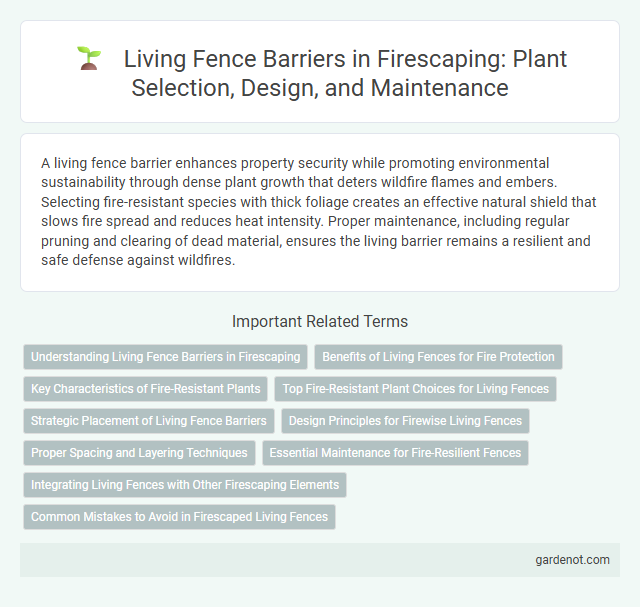A living fence barrier enhances property security while promoting environmental sustainability through dense plant growth that deters wildfire flames and embers. Selecting fire-resistant species with thick foliage creates an effective natural shield that slows fire spread and reduces heat intensity. Proper maintenance, including regular pruning and clearing of dead material, ensures the living barrier remains a resilient and safe defense against wildfires.
Understanding Living Fence Barriers in Firescaping
Living fence barriers in firescaping are strategically planted rows of fire-resistant shrubs and trees designed to slow the spread of wildfires and protect property. These natural firebreaks reduce wind speed and trap embers, significantly lowering fire intensity near vulnerable areas. Selecting drought-tolerant, low-resin species enhances the effectiveness and sustainability of living fence barriers in high-risk fire zones.
Benefits of Living Fences for Fire Protection
Living fences provide a natural barrier that slows the spread of wildfire by reducing wind speed and blocking embers. Plants with high moisture content in living fences act as a fire-resistant barrier, minimizing ignition risk. These green barriers also enhance landscape resilience and promote biodiversity while serving as effective firebreaks.
Key Characteristics of Fire-Resistant Plants
Fire-resistant plants used in living fence barriers typically possess thick, moist leaves with high water content that reduce flammability. They often have low levels of volatile oils and resins, which minimizes ignition risk during wildfires. Dense, well-maintained foliage creates an effective physical barrier that slows fire spread and provides protection to property and landscapes.
Top Fire-Resistant Plant Choices for Living Fences
Top fire-resistant plants for living fence barriers include California lilac (Ceanothus), Manzanita (Arctostaphylos), and Toyon (Heteromeles arbutifolia), which possess high moisture content and low volatile oils reducing flammability. These species create dense, green barriers that resist ignition and help slow wildfire spread along property lines. Selecting native fire-resistant shrubs enhances landscape resilience and supports local ecosystems while providing an effective natural firebreak.
Strategic Placement of Living Fence Barriers
Strategic placement of living fence barriers around properties enhances wildfire defense by creating effective fuel breaks that slow fire spread and protect structures. Positioning fire-resistant plant species in dense rows near vulnerable areas, such as along driveways and property perimeters, maximizes their ability to reduce ember intrusion and radiant heat exposure. Incorporating adequate spacing and maintaining moisture levels in living fences further boosts resilience against high-intensity fires, improving overall landscape survivability.
Design Principles for Firewise Living Fences
Living fence barriers designed for firewise landscaping incorporate fire-resistant plant species such as succulents, deciduous trees, and low-resin shrubs to minimize fuel load. Strategic spacing between plants and maintaining moisture levels reduce fire spread potential while enhancing air circulation. Integrating non-combustible materials like gravel or stone along the base further fortifies the fence against wildfire intrusion.
Proper Spacing and Layering Techniques
Proper spacing and layering techniques in living fence barriers enhance fire resistance by reducing fuel continuity and limiting fire spread. Strategic placement of fire-resistant plants with varying heights and moisture content creates effective fuel breaks, while maintaining adequate gaps prevents embers from igniting adjacent vegetation. Implementing these methods optimizes defensible space and strengthens the overall fire protection around properties.
Essential Maintenance for Fire-Resilient Fences
Regular pruning and clearing of dead branches are essential to maintain a living fence barrier's fire resilience, reducing available fuel for wildfires. Applying fire-resistant plant selections, such as drought-tolerant shrubs and native species with high moisture content, enhances the natural barrier's effectiveness. Consistent irrigation and removal of flammable debris ensure the fence remains a robust defensive perimeter against fire spread.
Integrating Living Fences with Other Firescaping Elements
Integrating living fence barriers with hardscape features such as stone retaining walls and gravel pathways enhances fire resistance by creating defensible spaces that slow wildfire spread. Combining drought-tolerant, fire-resistant plant species in the living fence with strategically placed mulch and irrigation improves overall landscape resilience to fire. Properly designed living fences act as firebreaks while also supporting biodiversity and aesthetic appeal in firescaping plans.
Common Mistakes to Avoid in Firescaped Living Fences
Common mistakes to avoid in firescaped living fences include planting highly flammable species such as junipers or eucalyptus too close to structures, increasing wildfire risk. Neglecting proper maintenance, like frequent pruning and removal of dead vegetation, leads to excessive fuel buildup that intensifies fire hazards. Selecting densely spaced plants without considering airflow restrictions can trap heat and embers, undermining the effectiveness of the living fence barrier in fire protection.
Living fence barrier Infographic

 gardenot.com
gardenot.com